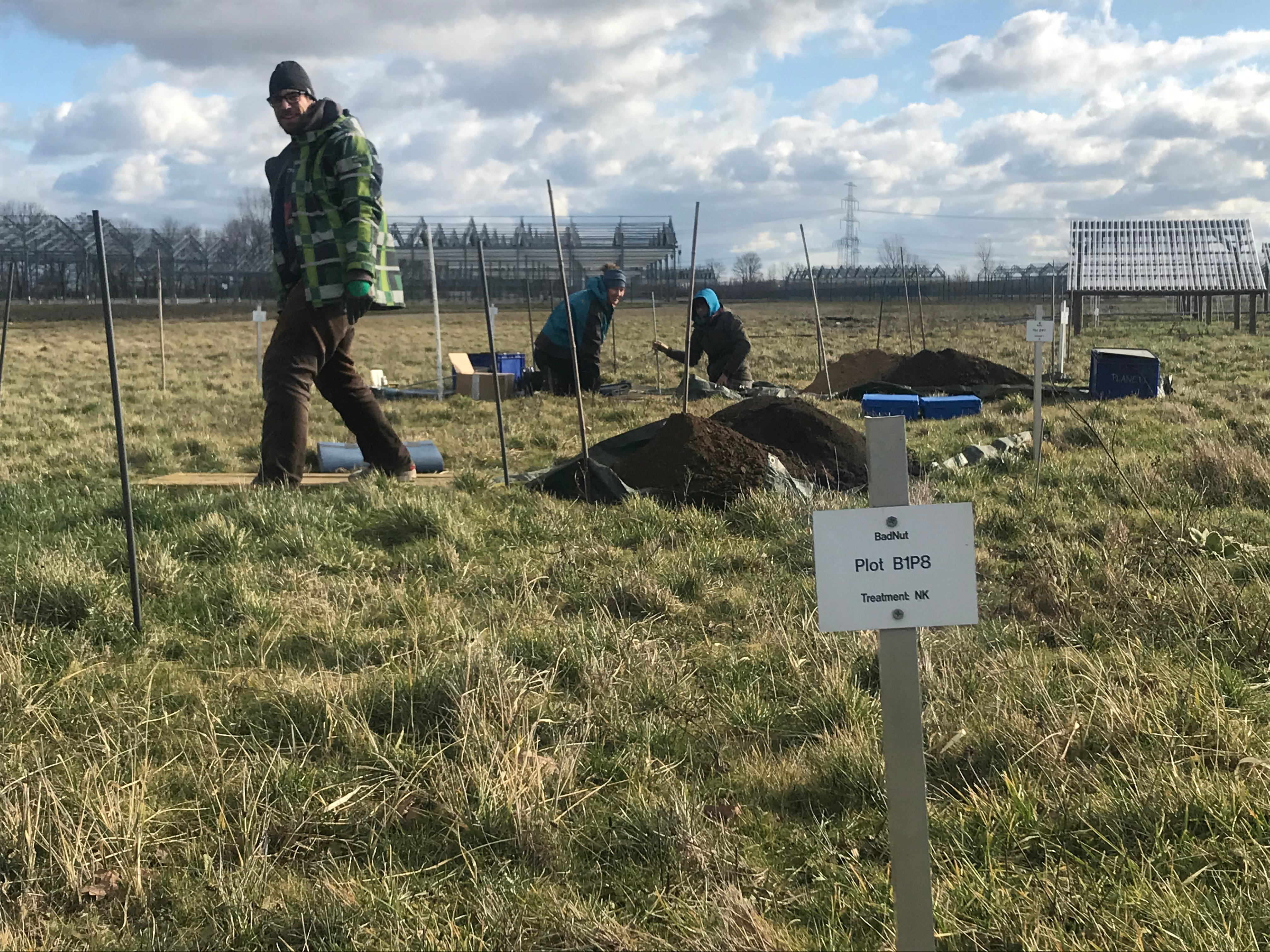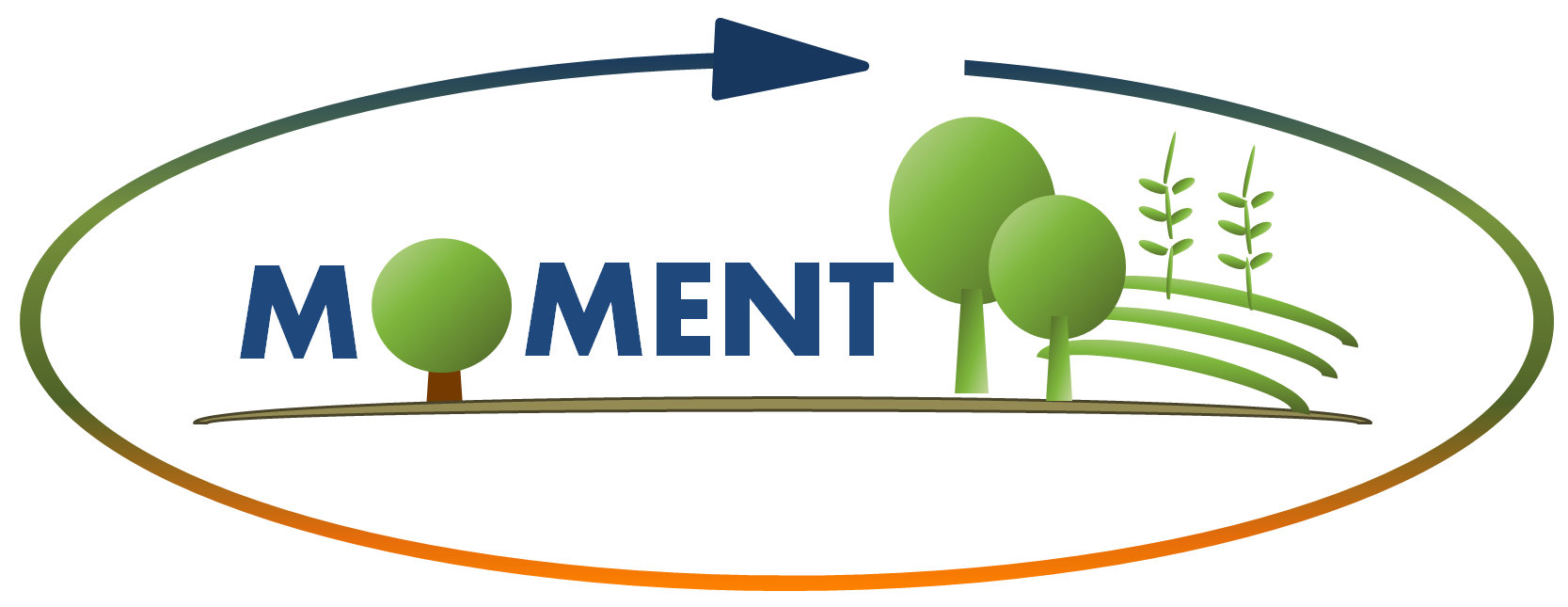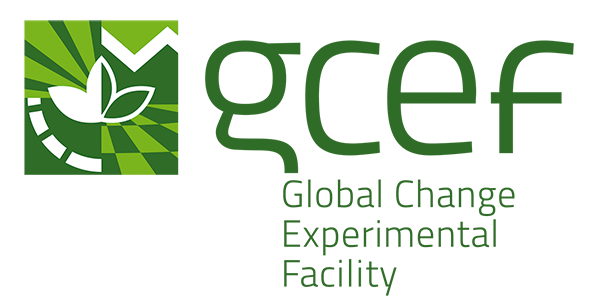Terrestrial Ecohydrology

Research Focus
We work at the interface between vegetation and the hydrosystem and focus on the vertical connection between soil and atmosphere. We work on both flow directions up and down. We investigate canopy and soil processes and are specifically interested into how vegetation interacts with and creates spatial heterogeneity of fluxes and soil water states.
In our work group we focus on:
- Pattern formation by canopies and root water uptage and effect on surface flux partitioning
- Vegetation adaptation to water stress
- Integrated modelling of vegetation and the water cycle
Group Members
Prof. Anke
Hildebrandt
Bahar
Bahrami
Sven
Westermann
Dr. Friedrich
Bohn


Charlotte
Kihm
Simon
Lüdke
Projects
For general information on the projects, please click on the links below each logo which will lead you to the project websites.
For short descriptions of our work in the projects, please open boxes
here
.
Short Project Descriptions
Root water uptake in anthropogenic change

Root water uptake can adapt quickly to changing environmental conditions. For example, ecosystems shift uptake downwards, when water is scarce. Here we investigste, how this capacity of the ecosystems depends on the management, changing climate conditions and especially the availability of other resouces that are also acquired by the root systems, like nitrogen. In this PhD project, we use soil moisture information in the Global Change Experimental Facility and in the Nutrient Network, with the aim to improve representation of plant resource acquisition in models.
Contact: Sven Westermann , Anke Hildebrandt
A Parsimonious Canopy Model (PCM)
Temperate forest ecosystems play a crucial role in governing global carbon and water cycles. The total carbon uptake of ecosystems by photosynthesis (GPP) is the largest flux between the land and the atmosphere within the carbon cycle. It is intrinsically linked to the canopy leaf production and potentially strongly affected by drought. For the water cycle, leaf area index (LAI) plays a crucial role, as it affects both the interception of rainwater and the water loss during carbon uptake. Therefore, a prognostic simulated vegetation leaf area index (LAI) would substantially improve representation of the water cycle components in hydrological models (e.g., evapotranspiration), while GPP predictions would benefit from simulated soil water storage. Those two key variables can be estimated together by incorporating a light use efficiency concept into a hydrological model. But existing LUE-modules either require external (e.g. satellite-based) LAI dynamics which are subjected to uncertainty and/or the level of the model complexity (when LAI is also simulated) prohibits their integration into hydrologic models. In this project, we develop a parsimonious forest canopy model to simulate the daily development of both GPP and LAI, while ensuring adequate level of complexity to allow coupling into hydrological models.
Model description can be found here: Bahrami et al., GMD
Contact: Bahar Bahrami , Anke Hildebrandt
AquaDiva
The CRC AquaDiva is a Collaborative Research Centre funded by the German Science Foundation. It deals with the coupling between surface and subsurface processes within the Earth Critical Zone. Two exploratories have been established in the first two phases of this altogether twelve year long project.
Our working group contributes understanding on how surface structure, like vegetation type, diversity and management, affect where and how water enters into the subsurface, and which part enters the deeper subsurface. We also look at how carbon and nitrogen enter the subsurface, are transformed and transported below the main rooting zone. For this, we couple the ecological model FORMIND to the hydrological model mHM and add a module that accounts for nutrient and carbon turnover in the forest soils. The models will first be adopted at the intensive monitoring sites of our project partners and than further extended to larger watersheds to allow generalization of the results.
Using the coupled model, we want to investigate, how land use management or changes in ecosystem structure due to extreme climate events, affect the input of water and matter to the deeper subsurface.
Contact: Friedrich Bohn , Anke Hildebrandt
Cooperations
Teaching
The group contributes to teaching at the Institute of Geoscience at the Friedrich Schiller University of Jena:
- Preparatory class in Mathematics for incoming students of the BSc Geosciences (3-5 day block course)
- Module Ecohydrology for the BSc Biogeosciences (3rd year)
- Lecture Geostatistics for MSc Environmental and Georesources Management, Geosciences and Biogeosciences
Publications
- Fischer-Bedtke, C., Metzger, J.C., Demir, G., Wutzler, T., Hildebrandt, A. (2023):
Throughfall spatial patterns translate into spatial patterns of soil moisture dynamics – empirical evidence
Hydrol. Earth Syst. Sci. 27 (15), 2899 - 2918 10.5194/hess-27-2899-2023 - Pint, A., Hildebrandt, A., Landwehrs, J., Feulner, G., Scholze, F., Nyakatura, J., Ispas, L., Grützner, C., Frenzel, P. (2023):
Contour marks as potential indicators of evaporation rates in the early Permian continental vertebrate site Bromacker (Thuringia, Central Germany)
Paleogeogr. Paleoclimatol. Paleoecol. 628 , art. 111749 10.1016/j.palaeo.2023.111749 - Pohl, F., Rakovec, O., Rebmann, C., Hildebrandt, A., Boeing, F., Hermanns, F., Attinger, S., Samaniego, L., Kumar, R. (2023):
Long-term daily hydrometeorological drought indices, soil moisture, and evapotranspiration for ICOS sites
Sci. Data 10 , art. 281 10.1038/s41597-023-02192-1 - Pohl, F., Werban, U., Kumar, R., Hildebrandt, A., Rebmann, C. (2023):
Observational evidence of legacy effects of the 2018 drought on a mixed deciduous forest in Germany
Sci. Rep. 13 , art. 10863 10.1038/s41598-023-38087-9 - van der Plas, F., Schröder-Georgi, T., Weigelt, A., Barry, K., Meyer, S., Alzate, A., Barnard, R.L., Buchmann, N., de Kroon, H., Ebeling, A., Eisenhauer, N., Engels, C., Fischer, M., Gleixner, G., Hildebrandt, A., Koller-France, E., Leimer, S., Milcu, A., Mommer, L., Niklaus, P.A., Oelmann, Y., Roscher, C., Scherber, C., Scherer-Lorenzen, M., Scheu, S., Schmid, B., Schulze, E.-D., Temperton, V., Tscharntke, T., Voigt, W., Weisser, W., Wilcke, W., Wirth, C. (2023):
Reply to: Plant traits alone are good predictors of ecosystem properties when used carefully
Nat. Ecol. Evol. 7 (3), 335 - 336 10.1038/s41559-022-01957-y
- Bahrami, B., Hildebrandt, A., Thober, S., Rebmann, C., Fischer, R., Samaniego, L., Rakovec, O., Kumar, R. (2022):
Developing a parsimonious canopy model (PCM v1.0) to predict forest gross primary productivity and leaf area index of deciduous broad-leaved forest
Geosci. Model Dev. 15 (18), 6957 - 6984 10.5194/gmd-15-6957-2022 - Bahrami, B., Hildebrandt, A., Thober, S., Rebmann, C., Fischer, R., Samaniego, L., Rakovec, O., Kumar, R. (2022):
Parsimonious Canopy Model (PCM) v1.0
Version: v1.0 Zenodo 10.5281/zenodo.6373776 - Bahrami, B., Kumar, R., Thober, S., Hildebrandt, A., Fischer, R., Samaniego, L., Rebmann, C. (2022):
Predicting forest gross primary productivity and leaf area index by coupling light use efficiency and leaf phenology in a parsimonious canopy model
EGU General Assembly 2022, Vienna, Austria, 23–27 May 2022
EGUsphere
Copernicus Publications, EGU22-8844 10.5194/egusphere-egu22-8844 - Boeing, F., Kleidon-Hildebrandt, A., Rebmann, C., Kumar, R., Samaniego-Eguiguren, L., Marx, A., Rakovec, O., Schrön, M., Thober, S., Müller, S., Schneider, K., Zacharias, S., Bogena, H., Kiese, R. (2022):
[German Drought Monitor] HESS publication deseasonalized soil moisture data [Data set]
Data Investigation Portal UFZ 10.48758/ufz.12541 - Boeing, F., Rakovec, O., Kumar, R., Samaniego, L., Schrön, M., Hildebrandt, A., Rebmann, C., Thober, S., Müller, S., Zacharias, S., Bogena, H., Schneider, K., Kiese, R., Attinger, S., Marx, A. (2022):
High-resolution drought simulations and comparison to soil moisture observations in Germany
Hydrol. Earth Syst. Sci. 26 (19), 5137 - 5161 10.5194/hess-26-5137-2022 - Demir, G., Friesen, J., Filipzik, J., Michalzik, B., Hildebrandt, A. (2022):
A method proposal for throughfall measurement in grassland at plot scale in temperate climate: ‘Interception tubes’
Front. Earth Sci. 10 , art. 799419 10.3389/feart.2022.799419 - Demir, G., Michalzik, B., Filipzik, J., Metzger, J.C., Hildebrandt, A. (2022):
Spatial variation of grassland canopy affects soil wetting patterns and preferential flow
Hydrol. Process. 36 (12), e14760 10.1002/hyp.14760 - Khurana, S., Heße, F., Hildebrandt, A., Thullner, M. (2022):
Should we worry about surficial dynamics when assessing nutrient cycling in the groundwater?
Front. Water 4 , art. 780297 10.3389/frwa.2022.780297 - Khurana, S., Heße, F., Hildebrandt, A., Thullner, M. (2022):
Predicting the impact of spatial heterogeneity on microbially mediated nutrient cycling in the subsurface
Biogeosciences 19 (3), 665 - 688 10.5194/bg-19-665-2022 - Kroll, J., Denissen, J.M.C., Migliavacca, M., Li, W., Hildebrandt, A., Orth, R. (2022):
Spatially varying relevance of hydrometeorological hazards for vegetation productivity extremes
Biogeosciences 19 (2), 477 - 489 10.5194/bg-19-477-2022 - Loritz, R., Bassiouni, M., Hildebrandt, A., Hassler, S.K., Zehe, E. (2022):
Leveraging sap flow data in a catchment-scale hybrid model to improve soil moisture and transpiration estimates
Hydrol. Earth Syst. Sci. 26 (18), 4757 - 4771 10.5194/hess-26-4757-2022 - Paulus, S.J., El-Madany, T.S., Orth, R., Hildebrandt, A., Wutzler, T., Carrara, A., Moreno, G., Perez-Priego, O., Kolle, O., Reichstein, M., Migliavacca, M. (2022):
Resolving seasonal and diel dynamics of non-rainfall water inputs in a Mediterranean ecosystem using lysimeters
Hydrol. Earth Syst. Sci. 26 (23), 6263 - 6287 10.5194/hess-26-6263-2022 - Pohl, F., Rakovec, O., Rebmann, C., Hildebrandt, A., Boeing, F., Hermanns, F., Samaniego, L., Attinger, S., Kumar, R. (2022):
Long-term daily hydrometeorological drought indices, soil moisture, and evapotranspiration for ICOS sites
Zenodo 10.5281/zenodo.7561854 - You, X., Kallies, R., Hild, K., Hildebrandt, A., Harms, H., Chatzinotas, A., Wick, L.Y. (2022):
Transport of marine tracer phage particles in soil
Sci. Total Environ. 814 , art. 152704 10.1016/j.scitotenv.2021.152704
- Metzger, J.C., Filipzik, J., Michalzik, B., Hildebrandt, A. (2021):
Stemflow infiltration hotspots create soil microsites near tree stems in an unmanaged mixed beech forest
Front. For. Glob. Change 4 , art. 701293 10.3389/ffgc.2021.701293 - Paulus, S., El-Madany, T.S., Orth, R., Hildebrandt, A., Migliavacca, M. (2021):
Multi-source characterisation of non-rainfall water inputs to a semi-arid ecosystem
Lysimeter und Bodenwasserhaushalt: Trockenheit - Bewässerung - Ertragssicherheit. Bericht 19. Lysimetertagung, HBLFA Raumberg-Gumpenstein, 13. und 14. April 2021
p. 37 - 42
- Lange, M., Roth, V-N, Eisenhauer, N, Roscher, C, Dittmer, T, Fischer, C, Gonzales Mace, O, Hildebrandt, A, Milcu, A, Mommer, L, Oram, NJ, Ravenek, J, Scheu, S, Schmidt, S, Strecker, T, Wagg, C, Weigelt, A, Gleixner, G. 2021.
Plant diversity enhances production and downward transport of biodegradable dissolved organic matter.
Journal of Ecology 1009(3), 1284-1297, doi: 10.1111/1365-2745.13556
- Hildebrandt, A. (2020):
Root water relations and interactions in mixed forest settings
In: Levia, D.F., Carlyle-Moses, D.E., Iida, S., Michalzik, B., Nanko, K., Tischer, A. (eds.)
Forest-Water Interactions
Ecological Studies 240
Springer, Berlin, Heidelberg, New York, p. 319 - 348 10.1007/978-3-030-26086-6_14 - van der Plas, F., Schröder-Georgi, T., Weigelt, A., Barry, K., Meyer, S., Alzate, A., Barnard, R.L., Buchmann, N., de Kroon, H., Ebeling, A., Eisenhauer, N., Engels, C., Fischer, M., Gleixner, G., Hildebrandt, A., Koller-France, E., Leimer, S., Milcu, A., Mommer, L., Niklaus, P.A., Oelmann, Y., Roscher, C., Scherber, C., Scherer-Lorenzen, M., Scheu, S., Schmid, B., Schulze, E.-D., Temperton, V., Tscharntke, T., Voigt, W., Weisser, W., Wilcke, W., Wirth, C. (2020):
Plant traits alone are poor predictors of ecosystem properties and long-term ecosystem functioning
Nat. Ecol. Evol. 4 (12), 1602 - 1611 10.1038/s41559-020-01316-9 - Van Stan II, J.T., Hildebrandt, A., Friesen, J., Metzger, J.C., Yankine, S.A. (2020):
Spatial variability and temporal stability of local net precipitation patterns
In: Van Stan II, J.T., Gutmann, E., Friesen, J. (eds.)
Precipitation partitioning by vegetation - A global synthesis
Springer International Publishing, Cham, p. 89 - 103 10.1007/978-3-030-29702-2_6
- Lange, M., Koller-France, E., Hildebrandt, A., Oelmann, Y., Wilcke, W., Gleixner, G. (2019):
How plant diversity impacts the coupled water, nutrient and carbon cycles
In: Eisenhauer, N., Bohan, D.A., Dumbrell, A.J. (eds.)
Mechanisms underlying the relationship between biodiversity and ecosystem function
Advances in Ecological Research 61
Academic Press / Elsevier, London, p. 185 - 219 10.1016/bs.aecr.2019.06.005 - Metzger, J.C., Schumacher, J., Lange, M., Hildebrandt, A. (2019):
Neighbourhood and stand structure affect stemflow generation in a heterogeneous deciduous temperate forest
Hydrol. Earth Syst. Sci. 23 (11), 4433 - 4452 10.5194/hess-23-4433-2019
- Barry, K.E., J van Ruijven, L. Mommer, Y. Bai, C. Beierkuhnlein, N. Buchmann, H. de Kroon, A. Ebeling, N. Eisenhauer, C. Guimaraes-Steinicke, Anke Hildebrandt, F. Isbell, A. Milcu, C. Neßhöver, P. B. Reich, C. Roscher, L. Sauheitl, M. Scherer-Lorenzen, B. Schmid, D. Tilman, S. von Felten & A. Weigelt (2019):
Limited evidence for spatial resource partitioning across temperate grassland biodiversity experiments.
Ecology. 101(1), doi: 10.1002/ecy.2905 Fischer, C., Leimer, S., Roscher. C., Ravenek, J., de Kroon, H., Kreutziger, Y., Baade, J., Beßler, H., Eisenhauer, N., Weigelt, A., Mommer, L., Lange, M., Gleixner, G., Wilcke, W., Schröder, B., A. Hildebrandt (2019):
Plant species richness and functional groups have different effects on soil water content in a decade-long grassland experiment.
Journal of Ecology 107:127-141, doi: 10.1111/1365-2745.13046.
- Guderle, M., D. Bachmann, A. Milcu, A. Gockele, M. Bechmann, C. Fischer, C. Roscher, D. Landais, O. Ravel, S. Devidal, J. Roy, A. Gessler, N. Buchmann, A. Hildebrandt (2018):
Dynamic niche partitioning in root water uptake facilitates efficient water use in more diverse plant communities.Functional Ecology 32(1): 214-227. doi: 10.1111/1365-2435.12948
- Metzger, J., N. Dalla Valle, T. Wutzler, J. Filipzik, R. Lehmann, M. Roggenbuck, D. Schelhorn, J. Weckmüller, K. Küsel, K.U. Totsche, S. Trumbore, A. Hildebrandt (2017):
Vegetation impacts soil water content patterns by shaping canopy water fluxes and soil properties.
Hydrological Processes, doi: 10.1002/hyp.11274.
- Van Stan, J.T., Norman, Z., Meghoo, A., Friesen, J., Hildebrandt, A., Coté, J.-F., Moldanado, G. (2017):
Edge-to-stem variability in wet canopy evaporation from an urban tree row.
Boundary Layer Meteorology 165 (2): 295-310. doi: 10.1007/s10546-017-0277-7. - Weisser, W.W., C. Roscher, S. Meyer, A. Ebeling, , G. Luo, E. Allan, H. Beßler, R. Barnard, N. Buchmann, F. Buscot, C. Engels, C. Fischer, M. Fischer, A. Gessler, G. Gleixner, S. Halle, A. Hildebrandt, H. Hillebrand, H. de Kroon, M. Lange, S. Leimer, X. Le Roux, A. Milcu, L. Mommer, P. Niklaus, Y. Oelmann, R. Proulx, C. Scherber, M. Scherer-Lorenzen, S. Scheu, T. Tscharntke, M. Wachendorf, C. Wagg, A. Weigelt, W. Wilcke, E.-D. Schulze, B. Schmid, N. Eisenhauer (2017):
Biodiversity effects on ecosystem functioning in a 15-year grassland experiment: patterns, mechanisms, and open questions.
Basic and Applied Ecology 23: 1-74, doi: 10.1016/j.baae.2017.06.002
- Wollschläger, U., Attinger, S., Borchardt, D., Brauns, M., Cuntz, M., Dietrich, P., Fleckenstein, J.H., Friese, K., Friesen, J., Harpke, A., Hildebrandt, A., Jäckel, G., Kamjunke, N., Knöller, K., Kögler, S., Kolditz, O., Krieg, R., Kumar, R., Lausch, A., Liess, M., Marx, A., Merz, R., Mueller, C., Musolff, A., Norf, H., Oswald, S.E., Rebmann, C., Reinstorf, F., Rode, M., Rink, K., Rinke, K., Samaniego, L., Vieweg, M., Vogel, H.-J., Weitere, M., Werban, U., Zink, M., Zacharias, S., (2017):
The Bode hydrological observatory: a platform for integrated, interdisciplinary hydro-ecological research within the TERENO Harz/Central German Lowland Observatory.
Environ. Earth Sci. 76 (1), art. 29. doi:10.1007/s12665-016-6327-5.
- Arnold, S., Attinger, S., Frank, K., Baxter, P., Possingham, H., Hildebrandt, A. (2016):
Ecosystem management along ephemeral rivers: trading off socio-economic water supply and vegetation conservation under flood regime uncertainty
River Res. Appl. 32 (3), 219 - 233 10.1002/rra.2853
- Zimmermann, A., S. Voss, J.C. Metzger, A. Hildebrandt, B. Zimmermann (2016):
Capturing heterogeneity: The role of a study area's extent for estimating mean throughfall. Journal of Hydrology 542: 781-789. doi: 10.1016/j.jhydrol.2016.09.047 - Hildebrandt, A., A. Kleidon, and M. Bechmann (2016):
A thermodynamic formulation of root water uptake. Hydrology and Earth System Sciences 20: 3441-3454, doi: 10.5194/hess-20-3441-2016 - Milcu, A., W. Eugster, D. Bachmann, M. Guderle, Ch. Roscher, D. Landais, O. Ravel, A. Gessler, M. Lange, A. Ebeling, W. Weisser, J. Roy, A. Hildebrandt, N. Buchmann (2016):
Plant species and functional diversity increase grassland productivity-related water vapour fluxes: a combined Ecotron and modeling approach. Ecology 97(8): 2044-2054. doi: 10.1890/15-1110.1 - Van Stan, J., L. Elliott, A. Hildebrandt, C. Rebmann, J. Friesen (2016):
Interacting bark structure and rainfall conditions impact stemflow variability in a temperate beech-oak forest, Central Germany. Hydrological Science Journal 61: 2071-2083. doi: 10.1080/02626667.2015.1083104 - Renner, M., S. K. Hassler, T. Blume, M. Weiler, A. Hildebrandt, M. Guderle, S. J. Schymanski, and A. Kleidon (2016):
Dominant controls of transpiration along a hillslope transect inferred from ecohydrological measurements and thermodynamic limits. Hydrology and Earth System Sciences 20: 2063-2083, doi: 10.5194/hess-20-2063-2016.
- Arnold, S., Attinger, S., Frank, K., Hildebrandt, A. (2015):
Assessing the structural adequacy of alternative ecohydrological models using a pattern-oriented approach
Ecol. Model. 316 , 52 - 61 10.1016/j.ecolmodel.2015.08.003
- Fischer, C., J. Tischer, C. Roscher, N. Eisenhauer, J. Ravenek, G. Gleixner, S. Attinger, B. Jensen, H. de Kroon, L. Mommer, S. Scheu, A. Hildebrandt (2015):
Plant species diversity affects infiltration capacity in an experimental grassland through changes in soil properties. Plant and Soil. 397: 1-16. doi: 10.1007/s11104-014-2373-5 - Guderle, M. and Hildebrandt, A. (2015):
Using measured soil water contents to estimate evapotranspiration and root water uptake profiles – a comparative study. Hydrology and Earth Systems Sciences. 19: 409-425. doi: 10.5194/hess-19-409-2015
- Fischer, C., Roscher, C., Jensen, B., Eisenhauer, N., Baade, J., Attinger, S., Scheu, S., Weisser, W.W., Schumacher, J., Hildebrandt, A. (2014):
How do earthworms, soil texture and plant composition affect infiltration along an experimental plant diversity gradient in grassland?
PLOS One 9 (6), e98987 10.1371/journal.pone.0098987
- Bechmann, M., C. Schneider, A. Carminati, D. Vetterlein, S. Attinger, A. Hildebrandt (2014):
Effect of parameter choice in root water uptake models – the arrangement of root hydraulic properties within the root architecture affects dynamics and efficiency of root water uptake.
Hydrology and Earth System Sciences 18, 4189–4206. doi: 10.5194/hess-18-4189-2014. - Milcu, A., C. Roscher, D. Bachmann, A. Gockele, M. Guderle, D. Landais, C. Piel, C. Escpape, S. Devidal, O. Ravel, N. Buchmann, A. Gessler, G. Gleixner, A. Hildebrandt, J. Roy. (2014):
Functional diversity of leaf nitrogen concentrations drives grassland carbon fluxes.
Ecology Letters 17: 435-444. doi 10.1111/ele.12243. - Leimer, S., Y. Kreutziger, S. Rosenkranz, H. Bessler, C. Engels, A. Hildebrandt, Y. Oelmann, W. Weisser, C. Wirth, W. Wilcke. (2014):
Plant diversity effects on the water balance of an experimental grassland.
Ecohydrology 7, 1378–1391. doi 10.1002/eco.1464 - Anthonj, C., S. Beskow, F. Dornelles, A. Terumi Fushita, C. Alves Gelharte, P. Galvao, P. Gatti J, B. Gluecker, A. Hildebrandt, D. Karthe, P. Kotsila, K. Krause, A. Kledson Leal Silva, P. Lehmann, P. Moura, N. Andricioli Periotto, J. L. Rodrigues Filho, D.R. Lopes dos Santos, F. Selge, T. Silva, R.M. Soares, M. Strohbach, A. Suhogusoff, I. Wahnfried, I. Zaseda. (2014):
Water in Urban Regions: Building Future Knowledge to Integrate Land Use, Ecosystem Services and Human Health.
Science Policy Report, German National Academy of Sciences Leopoldina. ISBN: 978-3-8047-3332-9
- Tessema, S.G., Mirgorodsky, D., Merten, D., Hildebrandt, A., Attinger, S., Büchel, G. (2013):
Hydrochemical characterization of groundwater system of biodiversity experimental field: Jena, Germany
Environ. Earth Sci. 70 (2), 821 - 837 10.1007/s12665-012-2171-4
- Kalbacher, T., Delfs, J.-O., Shao, H., Wang, W., Walther, M., Samaniego, L., Schneider, C., Kumar, R., Musolff, A., Centler, F., Sun, F., Hildebrandt, A., Liedl, R., Borchardt, D., Krebs, P., Kolditz, O. (2012):
The IWAS-ToolBox: software coupling for an integrated water resources management
Environ. Earth Sci. 65 (5), 1367 - 1380 10.1007/s12665-011-1270-y
- Carminati, A., Schneider, C.L., Moradi, A.B., Zarebanadkouki, M., Vetterlein, D., Vogel, H.-J., Hildebrandt, A., Weller, U., Schüler, L., Oswald, S.E. (2011):
How the rhizosphere may favor water availability to roots
Vadose Zone J. 10 (3), 988 - 998 10.2136/vzj2010.0113 - Kalbacher, T., Schneider, C.L., Wang, W., Hildebrandt, A., Attinger, S., Kolditz, O. (2011):
Modeling soil-coupled water uptake of multiple root systems with automatic time stepping
Vadose Zone J. 10 (2), 727 - 735 10.2136/vzj2010.0099
- Alexandrov, G. A., D. Ames, G. Bellocchi, M. Bruen, N. Crout, M. Erechtchoukova, A. Hildebrandt, F. Hoffman, C. Jackisch, P. Khaiter, G. Mannina, T. Matsunaga, S.T. Purucker, M. Rivington, L. Samaniego (2011):
Technical assessment and evaluation of environmental models and software: Letter to the Editor.
Environmental Modelling & Software 26 (3):328–336. doi: 10.1016/j.envsoft.2010.08.004.
- Alexandrov, G.A., Ames, D., Bellocchi, C., Bruen, M., Crout, N., Erechtchoukova, M., Hildebrandt, A., Hoffmann, F., Jackisch, C., Khaiter, P., Mannina, G., Matsunaga, T., Purucker, S.T., Rivington, M., Samaniego, L. (2010):
Technical assessment and evaluation of environmental models and software: letter to the editor
Environ. Modell. Softw. 26 (3), 328 - 336 10.1016/j.envsoft.2010.08.004 - Kalbacher, T., Schneider, C.L., Wang, W., Hildebrandt, A., Attinger, S., Kolditz, O. (2010):
Computational efficient modelling of soil-coupled 3D root water uptake for multiple root systems
In: Carrera, J., Sánchez-Vila, X., Fernández-García, D., Bolster, D. (eds.)
Proceedings of the XVIII International Conference on Computational Methods in Water Resources (CMWR 2010), June 21 to 24, 2010, Barcelona, Spain
CIMNE, Barcelona, p. 1261 - 1268 - Proulx, R., Wirth, C., Voigt, W., Weigelt, A., Roscher, C., Attinger, S., Baade, J., Barnard, R.L., Buchmann, N., Buscot, F., Eisenhauer, N., Fischer, M., Gleixner, G., Halle, S., Hildebrandt, A., Kowalski, E., Kuu, A., Lange, M., Milcu, A., Niklaus, P.A., Oelmann, Y., Rosenkranz, S., Sabais, A., Scherber, C., Scherer-Lorenzen, M., Scheu, S., Schulze, E.-D., Schumacher, J., Schwichtenberg, G., Soussana, J.-F., Temperton, V.M., Weisser, W.W., Wilcke, W., Schmid, B. (2010):
Diversity promotes temporal stability across levels of ecosystem organization in experimental grasslands
PLoS One 5 (10), e13382 10.1371/journal.pone.0013382 - Raedig, C., Dormann, C.F., Hildebrandt, A., Lautenbach, S. (2010):
Reassessing Neotropical angiosperm distribution patterns based on monographic data: a geometric interpolation approach
Biodivers. Conserv. 19 (6), 1523 - 1546 10.1007/s10531-010-9785-1 - Schneider, C.L., Attinger, S., Delfs, J.-O., Hildebrandt, A. (2010):
Implementing small scale processes at the soil-plant interface - the role of root architectures for calculating root water uptake profiles
Hydrol. Earth Syst. Sci. 14 (2), 279 - 289 10.5194/hess-14-279-2010
- Arnold, S., Attinger, S., Frank, K., Hildebrandt, A. (2009):
Uncertainty in parameterisation and model structure affect simulation results in coupled ecohydrological models
Hydrol. Earth Syst. Sci. 13 (10), 1789 - 1807 10.5194/hess-13-1789-2009 - Hildebrandt, A., Eltahir, E.A.B. (2008):
Using a horizontal precipitation model to investigate the role of turbulent cloud deposition in survival of a seasonal cloud forest in Dhofar
J. Geophys. Res.-Biogeosci. 113 (G4), G04028 10.1029/2008JG000727 - Hildebrandt, A., Al Aufi, M., Amerjeed, M., Shammas, M., Eltahir, E.A.B. (2007):
Ecohydrology of a seasonal cloud forest in Dhofar: 1. Field experiment
Water Resour. Res. 43 (10), W10411 10.1029/2006WR005261 - Hildebrandt, A., Eltahir, E.A.B. (2007):
Ecohydrology of a seasonal cloud forest in Dhofar: 2. Role of clouds, soil type, and rooting depth in tree-grass competition
Water Resour. Res. 43 (11), W11411 10.1029/2006WR005262 - Hildebrandt, A., Eltahir, E.A.B. (2006):
Forest on the edge: seasonal cloud forest in Oman creates its own ecological niche
Geophys. Res. Lett. 33 (11), L11401 10.1029/2006gl026022










